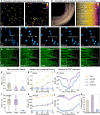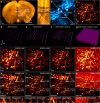System- and sample-agnostic isotropic three-dimensional microscopy by weakly physics-informed, domain-shift-resistant axial deblurring
- PMID: 39821085
- PMCID: PMC11739688
- DOI: 10.1038/s41467-025-56078-4
System- and sample-agnostic isotropic three-dimensional microscopy by weakly physics-informed, domain-shift-resistant axial deblurring
Abstract
Three-dimensional subcellular imaging is essential for biomedical research, but the diffraction limit of optical microscopy compromises axial resolution, hindering accurate three-dimensional structural analysis. This challenge is particularly pronounced in label-free imaging of thick, heterogeneous tissues, where assumptions about data distribution (e.g. sparsity, label-specific distribution, and lateral-axial similarity) and system priors (e.g. independent and identically distributed noise and linear shift-invariant point-spread functions are often invalid. Here, we introduce SSAI-3D, a weakly physics-informed, domain-shift-resistant framework for robust isotropic three-dimensional imaging. SSAI-3D enables robust axial deblurring by generating a diverse, noise-resilient, sample-informed training dataset and sparsely fine-tuning a large pre-trained blind deblurring network. SSAI-3D is applied to label-free nonlinear imaging of living organoids, freshly excised human endometrium tissue, and mouse whisker pads, and further validated in publicly available ground-truth-paired experimental datasets of three-dimensional heterogeneous biological tissues with unknown blurring and noise across different microscopy systems.
© 2025. The Author(s).
Conflict of interest statement
Competing interests: The authors declare no competing interests.
Figures






Similar articles
-
Single-Cell Resolution Three-Dimensional Imaging of Intact Organoids.J Vis Exp. 2020 Jun 5;(160). doi: 10.3791/60709. J Vis Exp. 2020. PMID: 32568249
-
Fast compressive lens-free tomography for 3D biological cell culture imaging.Opt Express. 2020 Aug 31;28(18):26935-26952. doi: 10.1364/OE.393492. Opt Express. 2020. PMID: 32906958
-
Virtual-scanning light-field microscopy for robust snapshot high-resolution volumetric imaging.Nat Methods. 2023 May;20(5):735-746. doi: 10.1038/s41592-023-01839-6. Epub 2023 Apr 6. Nat Methods. 2023. PMID: 37024654 Free PMC article.
-
3D deconvolution microscopy.Curr Protoc Cytom. 2010 Apr;Chapter 12:Unit 12.19.1-20. doi: 10.1002/0471142956.cy1219s52. Curr Protoc Cytom. 2010. PMID: 20373494 Review.
-
Biological applications of synchrotron radiation infrared spectromicroscopy.Biotechnol Adv. 2012 Nov-Dec;30(6):1390-404. doi: 10.1016/j.biotechadv.2012.02.012. Epub 2012 Feb 28. Biotechnol Adv. 2012. PMID: 22401782 Review.
References
-
- Gobel, W., Kampa, B. M. & Helmchen, F. Imaging cellular network dynamics in three dimensions using fast 3D laser scanning. Nat. Methods4, 73–79 (2007). - PubMed
-
- Olivier, N. et al. Cell lineage reconstruction of early zebrafish embryos using label-free nonlinear microscopy. Science329, 967–971 (2010). - PubMed
MeSH terms
LinkOut - more resources
Full Text Sources

